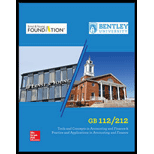
Concept explainers
Prepare the
Explanation of Solution
Common stock:
These are the ordinary shares that a corporation issues to the investors in order to raise funds. In return, the investors receive a share of profit from the profits earned by the corporation in the form of dividend.
Par value:
It refers to the value of a stock that is stated by the corporation’s charter. It is also known as face value of a stock.
Journal:
Journal is the method of recording monetary business transactions in chronological order. It records the debit and credit aspects of each transaction to abide by the double-entry system.
Rules of Debit and Credit:
Following rules are followed for debiting and crediting different accounts while they occur in business transactions:
- Debit, all increase in assets, expenses and dividends, all decrease in liabilities, revenues and stockholders’ equities.
- Credit, all increase in liabilities, revenues, and stockholders’ equities, all decrease in assets, expenses.
Journal entries for given transaction are as follows:
a. Issued 30,000 common shares at $40 per share and issued 5,000 shares of
| Date | Accounts title and explanation | Ref. | Debit ($) | Credit ($) |
| Cash (+A) (6) | 1,330,000 | |||
| Common stock (+SE) (1) | 1,200,000 | |||
| Preferred stock (+SE) (4) | 25,000 | |||
| Additional paid-in capital, preferred stock (+SE) (5) | 105,000 | |||
| (To record issuance of common stock and preferred stock) |
Table (1)
- Cash is an assets account and it increased the value of asset by $1,330,000. Hence, debit the cash account for $1,330,000.
- Common stock is a component of
stockholder’s equity and it increased the value of stockholder’s equity by $1,200,000, Hence, credit the common stock for $1,200,000. - Preferred stock is a component of stockholder’s equity and it increased the value of stockholder’s equity by $25,000. Hence, credit the preferred stock for $25,000.
- Additional paid-in capital, preferred stock is a component of stockholder’s equity and it increased the value of stockholder’s equity by $105,000. Hence, credit the additional paid-in capital, preferred stock account for $105,000.
Working note:
Calculate the value of common stock
Calculate the cash received from common stock
Calculate the value of preferred stock
Calculate the cash received from preferred stock
Calculate the value of additional paid in capital, preferred stock
Calculate the value of total cash received from preferred stock and common stock
b. Issued 9,000 shares of preferred stock at $20 each:
| Date | Accounts title and explanation | Ref. | Debit ($) | Credit ($) |
| Cash (+A) (8) | 64,000 | |||
| Preferred stock (+SE) (7) | 10,000 | |||
| Additional paid-in capital, preferred stock (+SE) (9) | 54,000 | |||
| (To record the issuance of preferred stock) |
Table (2)
- Cash is an assets account and it increased the value of asset by $64,000. Hence, debit the cash account for $64,000.
- Preferred stock is a component of stockholder’s equity and it increased the value of stockholder’s equity by $10,000. Hence, credit the preferred stock for $10,000.
- Additional paid-in capital, preferred stock is a component of stockholder’s equity and it increased the value of stockholder’s equity by $54,000. Hence, credit the additional paid-in capital, preferred stock account for $54,000.
Working note:
Calculate the value of preferred stock
Calculate the total cash received
Calculate the value of additional paid in capital, preferred stock
c. Repurchase of 3,000 common shares at $38 per share:
| Date | Accounts title and explanation | Ref. | Debit ($) | Credit ($) |
| Treasury stock (-SE) (10) | 114,000 | |||
| Cash (-A) | 114,000 | |||
| (To record the repurchase of common shares from investors) |
Table (3)
- Treasury stock is the contra-equity. There is an increase in the contra-equity which decreases the value of stockholders’ equity. Hence, debit the treasury stock with $114,000.
- Cash is an asset. There is a decrease in the asset. Hence, credit cash account with $144,000
Working note:
Calculate the value of repurchase of shares
Want to see more full solutions like this?
Chapter 11 Solutions
GB 112/212 MANAGERIAL ACC. W/ACCESS >C<
- Price and Efficiency Variances (22 points) The Livingston Corporation manufactures lamps. It has set up the following standards per finished unit for direct materials and direct manufacturing labor: 「 Direct Materials: 10 lb. at $5.20 per lb. Direct Manufacturing Labor: 0.5 hour at $30 per hour $52 $15.00 The number of finished unit budgeted for January 2017 was 9,940; 9,900 units were actually produced. Actual Results in January 2017 were as follows: 1.200 Direct Materials: 97,500 lb. used Direct Manufacturing Labor: 4,900 hours budg $155,575 During the month, materials purchases amounts to 99,400 lb., at a total cost of $536,760. Input price variances are isolated upon purchase. Input efficiency variances are isolated at the time of usage. Requirement Computer the January 2017 price and efficiency variances of direct materials and direct manufacturing labor. (Put a U for Unfavorable and a F for Favorable variances) 53670 Actual Costs Incurred Costs (Actual Input Qty. Actual Input…arrow_forwardMaple Grove Trading presents the following financial information Description Operating Expenses Amount 60,000 Sales Returns and Allowances 7,000 Sales Discounts Sales Revenue Cost of Goods Sold 10,000 200,000 95,000 What is Maple Grove Trading's gross profit? a. $98,000 b. $85,000 c. $88,000 d. $75,000arrow_forwardQuesti 6arrow_forward
 College Accounting, Chapters 1-27 (New in Account...AccountingISBN:9781305666160Author:James A. Heintz, Robert W. ParryPublisher:Cengage Learning
College Accounting, Chapters 1-27 (New in Account...AccountingISBN:9781305666160Author:James A. Heintz, Robert W. ParryPublisher:Cengage Learning College Accounting, Chapters 1-27AccountingISBN:9781337794756Author:HEINTZ, James A.Publisher:Cengage Learning,
College Accounting, Chapters 1-27AccountingISBN:9781337794756Author:HEINTZ, James A.Publisher:Cengage Learning, Financial AccountingAccountingISBN:9781337272124Author:Carl Warren, James M. Reeve, Jonathan DuchacPublisher:Cengage Learning
Financial AccountingAccountingISBN:9781337272124Author:Carl Warren, James M. Reeve, Jonathan DuchacPublisher:Cengage Learning Financial And Managerial AccountingAccountingISBN:9781337902663Author:WARREN, Carl S.Publisher:Cengage Learning,Principles of Accounting Volume 1AccountingISBN:9781947172685Author:OpenStaxPublisher:OpenStax College
Financial And Managerial AccountingAccountingISBN:9781337902663Author:WARREN, Carl S.Publisher:Cengage Learning,Principles of Accounting Volume 1AccountingISBN:9781947172685Author:OpenStaxPublisher:OpenStax College Accounting (Text Only)AccountingISBN:9781285743615Author:Carl Warren, James M. Reeve, Jonathan DuchacPublisher:Cengage Learning
Accounting (Text Only)AccountingISBN:9781285743615Author:Carl Warren, James M. Reeve, Jonathan DuchacPublisher:Cengage Learning





